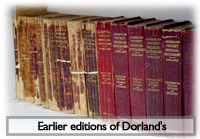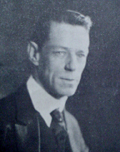About Dorland's Online
 The first dictionary in the Dorland's line, the American Pocket Medical Dictionary, edited by W.A. Newman Dorland, AM, MD, was first published in 1898 and was a small volume just over 500 pages long. It was followed two years later by the American Illustrated Medical Dictionary.
Both sprang from the fertile mind of Ryland W. Green, the illustrious longtime editor-in-chief at the W.B. Saunders Company, who remained intimately involved in their writing until he died in 1949 while at work on the 22nd edition of the big dictionary.
The first dictionary in the Dorland's line, the American Pocket Medical Dictionary, edited by W.A. Newman Dorland, AM, MD, was first published in 1898 and was a small volume just over 500 pages long. It was followed two years later by the American Illustrated Medical Dictionary.
Both sprang from the fertile mind of Ryland W. Green, the illustrious longtime editor-in-chief at the W.B. Saunders Company, who remained intimately involved in their writing until he died in 1949 while at work on the 22nd edition of the big dictionary.
The information contained in the dictionaries has, of course, changed considerably since the late 19th and early 20th centuries. No longer are dosages for drugs given (especially not in drams!). Nor does the new 32nd edition contain an entry for Keeley cure ("a proprietary method of treatment for the alcohol and opium habits by means of gold chlorid"-and yes, "chlorid" was the correct spelling at the time). The first edition contains no entry for the just developing specialty "immunology." Moreover, as the content has changed, so has the means of keeping it, moving from the time-honored card files to a full-fledged electronic content management system that allows us to update huge amounts of material across multiple print and electronic products with a minimum of effort.
Through all of these changes, the unifying force has been the focus on the users of the Dorland's references. Accuracy, authoritativeness, and usefulness have always been the aim of the creators and editors. Above all, the Dorland's products are created solely to be useful tools, and the experience of the user is the final standard by which they are judged.
Dorland's online and print products continue to carry forward the tradition of excellence established more than a century ago. The 32nd Edition of Dorland's Illustrated Medical Dictionary, published in 2012, includes nearly 124,000 entries, which is by far the largest number to be found in a single-volume medical dictionary. The entries in that edition are enhanced by more than 1,500 illustration's nearly all in full color. Approximately 500 of the illustrations were updated in this edition. The content of the 32nd edition has provided the foundation for the current version of the Dorland's Online Dictionary.
The Dorland's team remains indebted and grateful to the past and current writers, editors, and consultants whose work in writing and reviewing the content over the years continues to make Dorland's one of the most valuable medical references available. We also remain grateful to the many users who provide insight, corrections, criticism, and suggestions, as well as their esteem and support. Their ongoing interest helps maintain Dorland's stature as the most comprehensive and authoritative medical dictionary available.
William Alexander Newman Dorland, MD
 Doctor Dorland was born in Hilton Head, SC, in 1864, the son of Dr. William Matthews Dorland and Sarah A. Thorne. He received his MD in 1886 from the Medical School at the University of Pennsylvania, where he held his first academic position, Instructor of Obstetrics. In 1910, he moved to Chicago, where he was Professor of Obstetrics at Loyola University and Professor of Obstetrics and Gynecology at the Post-Graduate Medical College of Chicago. Following his retirement in 1951, he moved to Tampa, FL, where he resided until his death in 1956.
Doctor Dorland was born in Hilton Head, SC, in 1864, the son of Dr. William Matthews Dorland and Sarah A. Thorne. He received his MD in 1886 from the Medical School at the University of Pennsylvania, where he held his first academic position, Instructor of Obstetrics. In 1910, he moved to Chicago, where he was Professor of Obstetrics at Loyola University and Professor of Obstetrics and Gynecology at the Post-Graduate Medical College of Chicago. Following his retirement in 1951, he moved to Tampa, FL, where he resided until his death in 1956.
Dr. Dorland died in 1956, at which time the dictionaries were retitled to incorporate his name, which was how they had generally come to be known. Over the years, the list of consultants and contributors to the Dorland's dictionaries has included a large number of the most eminent names in medicine. The dictionaries themselves have grown in size to nearly 1000 pages for the 28th edition of Dorland's Pocket and nearly 2200 for the 32nd edition of Dorland's Illustrated (from 770 in the first edition).
About Elsevier
Elsevier is the leading provider of science and health information. We partner with experts around the globe to develop world-class content, delivering it in ways that fuel discovery, drive innovation, and improve health care. Our customers are deeply engaged in advancing knowledge, saving lives and improving the way we live. They are scientists and clinicians; authors and editors, professors, and students; information professionals and decision makers. We help them find the knowledge they need when and how they need it, providing trusted content and data along with tools and technology to navigate the ever-expanding universe of information. It's a relationship based on partnership; our customers help us understand how they work, so we can help them achieve outcomes that matter. From their daily achievements that advance the frontiers of science and health, to critical decisions in patient care and groundbreaking discoveries that have the power to transform the world, millions of professionals count on Elsevier.




